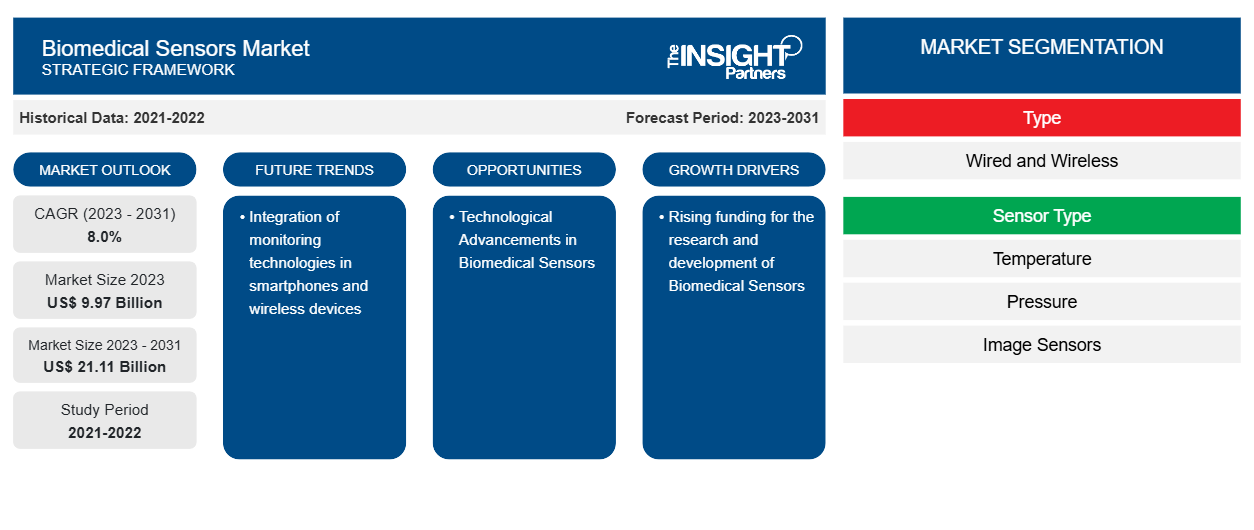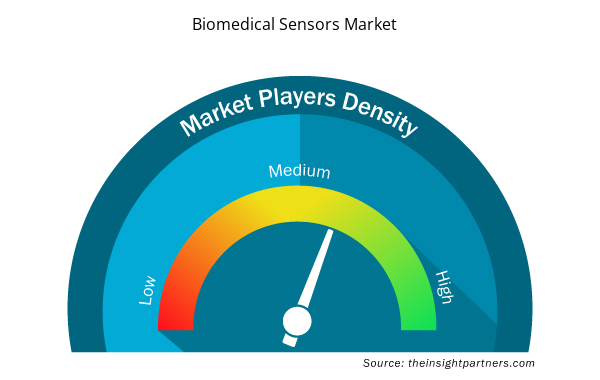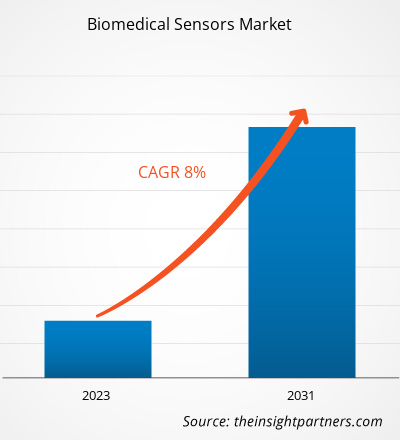The biomedical sensors market size is estimated to grow from US$ 9.97 billion in 2023 to US$ 21.11 billion by 2031; the market is estimated to record a CAGR of 8.0% during 2023–2031. The integration of monitoring technologies in smartphones and wireless devices is a critical trend in the biomedical sensors market.
Biomedical Sensors Market Analysis
Many private and government organizations are raising funds to support biomedical research. Funding aims to facilitate collaborative research among faculties in biomedical and engineering fields, with a focus on the development of biomedical devices, sensors, and systems. In April 2023, the SmartCare: HbA1c Self-Monitoring Technology Research Project, funded by the National Institute for Health Research (NiHR i4i Connect) with a grant worth US$ 186.7, was initiated with the main objective of experimentally validating a diabetes diagnostic tool that focuses on various blood biomarkers. Dr Iasonas Triantis from the Research Center for Biomedical Engineering at the School of Science and Technology was appointed ad the Principal Investigator (PI) on the study. Similarly, in February 2024, the Novo Nordisk Foundation generously awarded a grant of US$ 21.37 million toward the establishment of the Copenhagen Center for Biomedical Quantum Sensing. With this initiative, the field of biomedical and health sciences is set to undergo a major transformation with the advent of quantum sensing technology. This cutting-edge technology promises to revolutionize disease diagnosis and prevention with unprecedented precision. Through this international research collaboration, scientists aim to develop novel quantum sensing principles and techniques that can be used for the early detection of diseases.
Biomedical Sensors Market Overview
The growth of the biomedical sensors market is attributed to factors such as increasing adoption of IoT-based medical devices, burgeoning demand for home-based medical care, surging geriatric population, technological advancements in the medical device industry, and rising expenditure on healthcare across the world. The biomedical sensors market is segmented into North America, Europe, Asia Pacific, the Middle East & Africa, and South & Central America. North America holds the largest share of the market, and Asia Pacific is expected to record the fastest CAGR during 2023–2031. The US is estimated to account for the largest share of the biomedical sensors market. Market growth in the US is attributed to the efforts made by leading biomedical sensor vendors to establish their primary manufacturing bases, rising incidences of acute and chronic diseases among the population, and technological advancements in the healthcare sector in this country.
Customize This Report To Suit Your Requirement
You will get customization on any report - free of charge - including parts of this report, or country-level analysis, Excel Data pack, as well as avail great offers and discounts for start-ups & universities
Biomedical Sensors Market: Strategic Insights

- Get Top Key Market Trends of this report.This FREE sample will include data analysis, ranging from market trends to estimates and forecasts.
Customize This Report To Suit Your Requirement
You will get customization on any report - free of charge - including parts of this report, or country-level analysis, Excel Data pack, as well as avail great offers and discounts for start-ups & universities
Biomedical Sensors Market: Strategic Insights

- Get Top Key Market Trends of this report.This FREE sample will include data analysis, ranging from market trends to estimates and forecasts.
Biomedical Sensors Market Drivers and Opportunities
Rising Incidence of Lifestyle Diseases Favors Market
Various factors such as stress, obesity, a sedentary lifestyle, malnutrition, and tobacco and alcohol consumption contribute to the increasing prevalence of lifestyle-based diseases, including cardiovascular diseases (CVDs). According to the "Heart Disease and Stroke Statistics—2023" report by the American Heart Association, coronary heart disease was the most prevalent form of heart disease in 2021, claiming the lives of 375,476 individuals that year. Nearly 5% of adults aged 20 and above are estimated to have coronary artery disease (CAD). Therefore, there is an increased need for biomedical sensors with the rising incidence of lifestyle diseases, which can be used for regular health monitoring. State-of-the-art CVD biosensors and monitoring bioelectronics introduced in the recent past, either wearable or implantable, have enabled the continuous measurement of cardiac markers.
Technological Advancements in Biomedical Sensors to Bolster Market in Future
Technological advancements in biomedical sensors with the integration of micro-technology and nanotechnology are resulting in the introduction of compact, robust, innovative, and cost-effective sensors that are adaptable to the genetic makeup of every individual. These sensors are set to trigger alerts when they record unpredictable readings, screen the blood for the presence of toxic agents, and empower drugs straight into the circulatory system. Increasing investments in the development and regulatory approval of such advanced sensors is likely to boost the biomedical sensors market in the coming years. In addition, emerging applications of biomedical sensors in the field of nanotechnology and continuous innovations are leading to the development of advanced noninvasive sensor-based medical procedures. In February 20201, researchers at Missouri S&T designed an oxygen-sensing patch printed on a disposable, flexible bandage that can be connected to a smartphone. This smart bandage could allow remote monitoring for the early detection of conditions such as pressure ulcers, facilitating immediate treatment or intervention.
Biomedical Sensors Market Report Segmentation Analysis
Key segments that contributed to the derivation of the biomedical sensors market analysis are type, sensor type, product, and application.
- Based on type, the biomedical sensors market is bifurcated into wired and wireless. The wireless segment held a larger market share in 2023.
- By sensor type, the market is segmented into temperature, pressure, image sensors, biochemical, inertial sensors, motion sensors, electrocardiogram, and other sensor types. The temperature segment held the largest share of the market in 2023.
- In terms of product, the market is bifurcated into invasive sensors and noninvasive sensors. The noninvasive sensors segment held a larger share of the market in 2023.
- Based on application, the market is segmented into medical diagnostics, clinical therapy, imaging, and personal healthcare. The medical diagnostics segment held the largest share of the market in 2023.
Biomedical Sensors Market Share Analysis by Geography
The geographic scope of the biomedical sensors market report is mainly divided into five regions: North America, Asia Pacific, Europe, Middle East & Africa, and South & Central America. North America dominates the global biomedical sensors market. As per the World Health Organization (WHO), nearly 30 million people suffer from stroke each year. The American Heart Association states that more than 130 million people in the US are estimated to have a type of cardiovascular disease (CVD) by 2035. Thus, the rising prevalence of CVDs is ascribed to the dominance of North America in the global market.
Biomedical Sensors Market Regional Insights
The regional trends and factors influencing the Biomedical Sensors Market throughout the forecast period have been thoroughly explained by the analysts at Insight Partners. This section also discusses Biomedical Sensors Market segments and geography across North America, Europe, Asia Pacific, Middle East and Africa, and South and Central America.

- Get the Regional Specific Data for Biomedical Sensors Market
Biomedical Sensors Market Report Scope
| Report Attribute | Details |
|---|---|
| Market size in 2023 | US$ 9.97 Billion |
| Market Size by 2031 | US$ 21.11 Billion |
| Global CAGR (2023 - 2031) | 8.0% |
| Historical Data | 2021-2022 |
| Forecast period | 2023-2031 |
| Segments Covered |
By Type
|
| Regions and Countries Covered | North America
|
| Market leaders and key company profiles |
Biomedical Sensors Market Players Density: Understanding Its Impact on Business Dynamics
The Biomedical Sensors Market market is growing rapidly, driven by increasing end-user demand due to factors such as evolving consumer preferences, technological advancements, and greater awareness of the product's benefits. As demand rises, businesses are expanding their offerings, innovating to meet consumer needs, and capitalizing on emerging trends, which further fuels market growth.
Market players density refers to the distribution of firms or companies operating within a particular market or industry. It indicates how many competitors (market players) are present in a given market space relative to its size or total market value.
Major Companies operating in the Biomedical Sensors Market are:
- Analog Devices, Inc.
- GE Healthcare
- STMicroelectronics
- Honeywell International
- Medtronic
- NXP Semiconductors N.V.
Disclaimer: The companies listed above are not ranked in any particular order.

- Get the Biomedical Sensors Market top key players overview
Biomedical Sensors Market News and Recent Developments
The biomedical sensors market is evaluated by gathering qualitative and quantitative data post primary and secondary research, which includes important corporate publications, association data, and databases. A few of the key developments in the biomedical sensors market are listed below:
- Abbott acquired Bigfoot Biomedical, a company that has expertise in developing smart insulin management systems for individuals with diabetes. The Bigfoot Unity smart insulin management system developed by Bigfoot Biomedical utilizes connected insulin pen caps, and its operations are based on integrated continuous glucose monitoring (iCGM) data and healthcare providers’ instructions. (Source: Abbott, Press Release, 2023)
- Onera Health launched its first Onera Biomedical Lab-on-Chip. The biomedical sensor system-on-chip is designed to acquire and process multiple biosignals, and it is suitable for a wide range of wearable health devices as well as applications. It offers many solutions and opportunities for innovations in the medical, wellness, and fitness industries. (Source: Onera Technologies B.V., Press Release, 2022)
Biomedical Sensors Market Report Coverage and Deliverables
The “Biomedical Sensors Market Size and Forecast (2021–2031)” report provides a detailed analysis of the market covering below areas:
- Biomedical sensors market size and forecast at global, regional, and country levels for all the key market segments covered under the scope
- Biomedical sensors market trends as well as market dynamics such as drivers, restraints, and key opportunities
- Detailed PEST/Porter’s Five Forces and SWOT analysis
- Biomedical sensors market analysis covering key market trends, global and regional framework, major players, regulations, and recent market developments
- Industry landscape and competition analysis covering market concentration, heat map analysis, prominent players, and recent developments in the biomedical sensors market
- Detailed company profiles
- Historical Analysis (2 Years), Base Year, Forecast (7 Years) with CAGR
- PEST and SWOT Analysis
- Market Size Value / Volume - Global, Regional, Country
- Industry and Competitive Landscape
- Excel Dataset



Report Coverage
Revenue forecast, Company Analysis, Industry landscape, Growth factors, and Trends

Segment Covered
Type , Product , and Application and Geography

Regional Scope
North America, Europe, Asia Pacific, Middle East & Africa, South & Central America

Country Scope
Argentina, Australia, Brazil, Canada, China, France, Germany, India, Indonesia, Italy, Japan, Mexico, Saudi Arabia, South Africa, South Korea, Spain, United Arab Emirates, United Kingdom, United States
Trends and growth analysis reports related to Life Sciences : READ MORE..
- Analog Devices, Inc.
- GE Healthcare
- STMicroelectronics
- Honeywell International
- Medtronic
- NXP Semiconductors N.V.
- Pinnacle Technology Inc.
- Sensirion AG
- TE Connectivity
- Texas Instruments Incorporated

 Get Free Sample For
Get Free Sample For